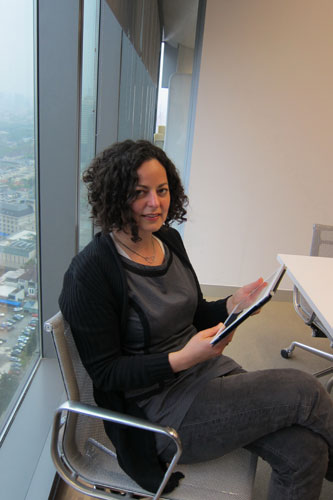CarbonBuzz to be introduced in China
Updated: 2012-04-17 17:13
By Chen Qide (chinadaily.com.cn)
|
|||||||||||
SHANGHAI - British researchers are preparing to introduce their newly-developed low-carbon construction technology into China to help reduce energy use.
Aedas, one of the world's largest architecture practices, is planning to build a Chinese stakeholder group consisting of local developers, landlords, contractors, the China Green Building Council, academic institutions, the Institute of Building Research and others to test a new technology called CarbonBuzz in the Chinese market, said Judit Kimpian, chairman of CarbonBuzz.
This online platform, which aims to revolutionize low-energy construction, was developed by a 12-person steering group made up of architects, engineers, software developers and professional bodies and academics. Partners are led by Aedas on behalf of the Chartered Institute of Building Services Engineers and the Royal Institute of British Architects with contributions from University College London, Aecom, the Building Research Establishment, Autodesk and other companies.
 |
|
Judit Kimpian, chairman of CarbonBuzz, explains the way of how to test a new technology called CarbonBuzz in China in an interview. [Photo/chinadaily.com.cn] |
Kimpian said that latest government-funded research points to the fact that new buildings and refurbishments in Britain fall substantially short of achieving their expected carbon reductions.
"CarbonBuzz has been successfully applied to Britain's about 300 projects in the past years. On average non-domestic (public) buildings can save up to 15-20 per cent of energy compared to what they currently use," she said.
Chinais an enormous market, where a great number of buildings are expected to spring up in the next decades. This calls for new carbon-reducing technologies, said Kimpian, also director of Sustainable Architecture & Research, Aedas Ltd.
Statistics show that buildings in China at the moment account for over 1.7 billion tons of CO2 emissions per annum, 21 per cent of which is coming from non-domestic buildings.
"If a Chinese CarbonBuzz pilot can demonstrate similar energy reductions, we could potentially save more than 20 billion yuan per annum," said Benny Chow, director of Sustainability Aedas Ltd.
"CarbonBuzz demonstrated a very high cost-benefit approach to support the realization of these savings in the urban development of the cities," he said.
"We want to set up a group in China by cooperating with Chinese partners to verify this," Kimpian said, adding that the aim is ultimately to help organizations that fund low carbon measures to track how these savings have been realized.
The British stakeholder group, established in 2006, has been promoting public awareness of operational energy use, for both government and private organizations who want to know whether their investment in low carbon measures and technologies can achieve the anticipated benefits.
The research has led to a development of the cloud computing platform, which is supported by an energy consumption database of projects.The embedded algorithms help users evaluate and benchmark a single building's or a portfolio's performance.
"CarbonBuzz has as an intuitive user interface, which reveals the gap between designed energy consumption and operating energy use," said Chow.
He said Aedas R&D group started the development of the platform in 2007 to allow all built environment professionals to benchmark their buildings' carbon emissions anonymously, conduct energy risks assessments and share lessons learned from best practice examples.
"A similar pilot will be conducted in China to develop this technology with Chinese characteristics, while making the most of the British experience," Kimpian said.
"The Chinese market has huge potential but more effort will be needed to raise local awareness of the savings that can be achieved by tracking energy consumption using this new technology," she said.
"We plan to start our pilots in two to three Chinese coastal areas first," Kimpian said, "then extend to other areas once we have adapted the platform to local requirements."